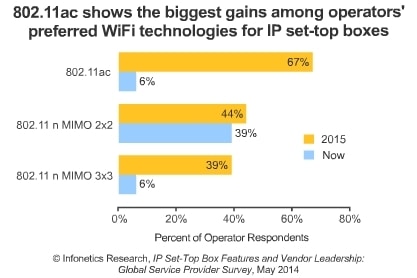Any content from anywhere' - this is the biggest driver for the growth in the IP Set-Top Box, an alternative to the traditional television experience in an increasing number of homes today.

As more content becomes digital, and with the proliferation of online media applications, content subscribers access the widest variety of content from a simple end device, resulting in rapid increase in the growth of this technology segment and an increasing number of IPTV providers enhancing their content delivery capabilities and end-user experience using better and more advanced IP set-top boxes.
Infonetics Research, a market research firm, via its 2014 IP Set-Top Box Features and Vendor Leadership: Global Service Provider Survey, highlighted the following:
802.11n dual-mode and 2x2 MIMO are currently the most widely-used WiFi technologies on IP set-top boxes (STBs), though 802.11ac shows the biggest gains among survey participants, growing from 6% today to 67% next year
-
Operator respondents rated TR-069 for remote device/service-level management and hard drive for integrated DVR support as the top IP STB features
-
Remote programming via tablet or mobile device heads the list of IP STB applications, rated highly by 67% of respondents, up 6 percentage points from last year’s survey
-
The top 3 IP STB suppliers currently installed by respondents are Arris/Motorola, Cisco, and Amino
"For set-top box (STB) vendors, the challenge is finding the right balance between adding new technologies and features while reducing costs to meet service providers’ demands and remain competitive. To do so, vendors need to build standard solutions instead of custom ones for each service provider"
“Adapting IP STB offerings for targeted markets is another factor. In China and India, low-cost IP STBs with fewer features, lower functionality, and more localized content are enough to meet customers’ needs, but in North America and Western Europe, there’s a growing appetite for more advanced STBs, like video gateways, which require a higher bill-of-materials cost, and the addition of more advanced features.”
- Jeff Heynen, Principal Analyst for Broadband Access and Pay TV, Infonetics Research




















